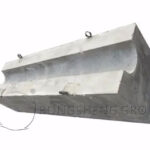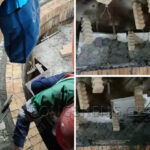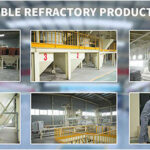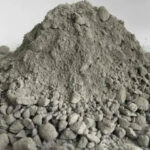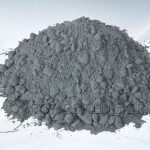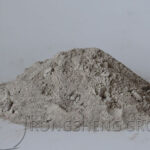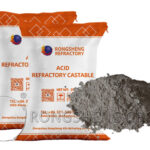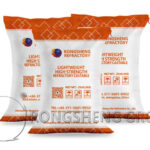Refractory castables are a type of refractory material that is mixed with a certain grade of refractory aggregates and powdery materials, binders, and admixtures and is used directly without going through the molding and firing processes.
In recent years, the output of unshaped refractory products has become higher and higher, and their application range has become wider and wider. Refractory castables do not need to be fired at high temperatures and can be used directly after being baked during construction. It is a new refractory material with a simple production process, saving energy and labor, mechanized construction, good integrity, easy repair, and long life.
According to the combination of raw materials, refractory castables can be divided into oxide refractory castables, non-oxide refractory castables, and composite refractory castables. Oxide refractory castables can be subdivided into non-alkaline refractory castables and alkaline refractory castables. Therefore, the performance of refractory castables mainly depends on the raw materials used in the formulation. In order to improve the performance of refractory castables, most manufacturers have used high-purity raw materials, homogeneous materials, electrofusion materials, synthetic materials, transformation materials, and ultra-fine powders as main raw materials. Let’s talk about the 24 raw materials that are often used in the formula of refractory castables.
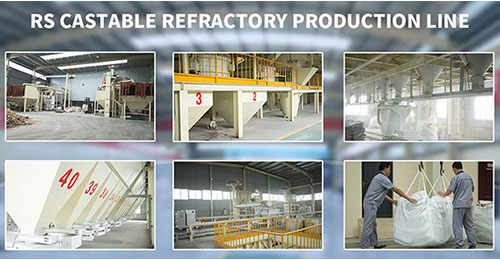
The Main Raw Material of Refractory Castables (1-12)
(1) Sintered corundum.
Sintered corundum, also known as sintered alumina or semi-fused alumina. It is a refractory clinker made from calcined alumina or industrial alumina as raw material, ground into balls or green bodies, and sintered at a high temperature of 1750~1900℃. Sintered alumina containing more than 99% of aluminum oxide is mostly made of uniform fine-grained corundum directly combined. The gas appearance rate is less than 3.0%, and the volume density reaches 3.60%/m³. The refractoriness is close to the melting point of corundum, and it has good volume stability and chemical stability at high temperatures. It is not corroded by reducing atmosphere, molten glass and molten metal, and has good mechanical strength and wear resistance at room temperature and high temperature.
(2) Fused corundum.
Fused corundum is artificial corundum made by melting pure alumina powder in a high-temperature electric furnace. It has the characteristics of high melting point, high mechanical strength, good thermal shock resistance, strong corrosion resistance and small linear expansion coefficient. Fused corundum is a raw material for manufacturing high-grade special refractory materials. Mainly include fused white corundum, fused brown corundum, sub-white corundum, etc.
(3) Fused white corundum.
Fused white corundum is made from pure alumina powder and smelted at high temperature. It is white in color. The smelting process of white corundum is basically a process of melting and recrystallization of industrial alumina powder, and there is no reduction process. The Al₂O₃ content is not less than 9%, and the impurity content is very small. The hardness is slightly smaller than brown corundum and the toughness is slightly lower. Often used to make abrasive tools, special ceramics and advanced refractory materials.
(4) Fused brown corundum.
Fused brown corundum is made from high-alumina bauxite as the main raw material and mixed with coke (anthracite), and is smelted in a high-temperature electric furnace at temperatures above 2000°C. The main chemical components are Al₂O₃, TiO₂ and contain a small amount of SiO₂ and Fe₂O₃. Fused brown corundum has a dense texture and high hardness and is often used in ceramics, precision castings and advanced refractory materials.
(5) Sub-white corundum.
Subwhite corundum is produced by electromelting special grade or first grade bauxite under reducing atmosphere and controlled conditions. When melting, add reducing agent (carbon), settling agent (iron filings) and decarburizing agent (iron scale). Because its chemical composition and physical properties are close to white corundum, it is called sub-white corundum. Its bulk density is above 3.80g/cm3 and its apparent porosity is less than 4%. It is an ideal material for manufacturing advanced refractory materials and wear-resistant materials.
(6) Mullite.
Mullite is a refractory raw material with 3Al₂O₃·2SiO₂ as the main crystal phase. Natural mullite is very rare and is usually synthesized artificially by sintering or electrofusion. Mullite has the characteristics of uniform expansion, good thermal shock stability, high load softening point, small high-temperature creep value, high hardness, and good chemical corrosion resistance.
(7) Zirconium corundum mullite.
Zirconium corundum mullite is made of industrial alumina, kaolin, and zircon as its main raw materials. It is synthesized by fine grinding, uniform mixing, semi-dry briquetting, and high-temperature calcination at 1600~1700℃. Increasing the zircon content will increase the sintering temperature, reduce the total shrinkage, and increase the closed pores. These reactions give sintered zirconium corundum mullite higher density and strength as well as better thermal shock resistance and slag resistance.
(8) Magnesia-aluminum spinel.
Magnesia-aluminum spinel is synthesized from industrial alumina and light-burned magnesium oxide through high-temperature sintering or electric fusion. The chemical formula of magnesia-aluminum spinel is MgO·Al₂O₃, in which the MgO content is 28.2% and the Al₂O₃ content is 71.8%. It has the advantages of high-temperature resistance, wear resistance, corrosion resistance, high melting point, small thermal expansion, low thermal stress, good thermal shock stability, strong resistance to alkaline slag erosion, and good electrical insulation properties.
(9) Sillimanite, andalusite, and kyanite.
The chemical formula is Al₂O₃·SiO₂, and the theoretical composition is Al₂O₃63.1% and SiO₂36.9%. After heating, they are irreversibly converted into mullite and cristobalite, which have the advantages of good slag corrosion resistance, good thermal shock stability, and high load softening point. Kyanite mineral products are high-quality raw materials for amorphous refractory materials. Because sillimanite and andalusite change little in volume when heated, they can be directly made into bricks or used as refractory aggregates. Kyanite expands greatly when heated and can be used directly as an expansion agent for amorphous refractory materials.
(10) High alumina bauxite.
my country’s high-alumina bauxite resources are mainly distributed in Shanxi, Henan, Guangxi and Guizhou. High-alumina bauxite clinker calcined at high temperature is mainly used for high-aluminum refractory materials, and can also be used to make fused brown corundum and sub-white corundum. In recent years, the homogenized alumina clinker produced in my country has been developed due to its low absorption rate and stable performance. The application in unshaped refractory materials has achieved good results.
(11) Soft clay.
The mineral composition of soft clay is mainly kaolinite or halloysite, mixed with other impurity minerals. The Al₂O₃ content can range from 22% to 38%, and the average refractoriness is around 1600℃. Soft clay is mostly earth-like, with fine particles, easily dispersed in water, and has strong plasticity and cohesiveness. It is widely used in plastics, ramming materials, gunning materials, refractory mud, and medium and low-grade refractory materials.
(12) Clay clinker.
Refractory clay clinker can be divided into two types according to the raw materials used and production methods. One type is obtained by calcining hard clay blocks directly in a kiln. The other type is made of kaolin or hard clay, which is finely ground, homogenized, filtered, dehydrated, dried, and finally burned in a kiln. It is a high-quality clay clinker. The main mineral phase of hard clay clinker is mullite, accounting for 35% to 55%. Followed by glass phase and cristobalite. Clay clinker is the main raw material of ordinary aluminum silicate refractory materials.
(To be continued. Since the article is too long, I will post it in two parts.)
By selecting different raw materials as the main raw materials of refractory castables, castables with different properties, operating temperatures and ranges can be made. Of course, only the main raw materials are not enough. Binders, admixtures and some special additives are also needed. These are all to improve the performance of refractory castables. Rongsheng Unshaped Refractory Castables Manufacturer is a powerful manufacturer and seller of refractory castables. Our environmentally friendly, fully-automatic unshaped refractory material production line provides high-quality customized refractory lining materials for high-temperature industrial furnaces. Contact us to get a free refractory lining solution and quote.

